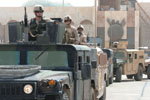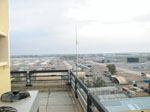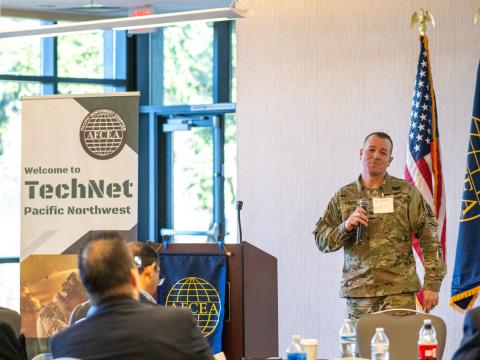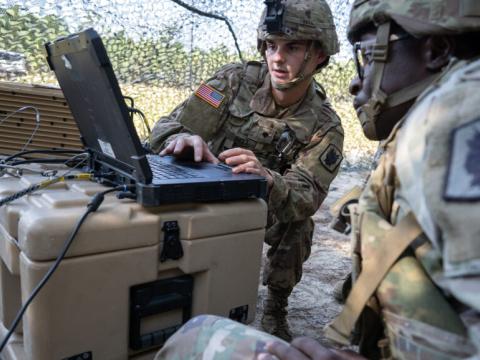Internet Protocol Network Protects Troop Convoys
 |
| Senior Airman Jonathon Ray, USAF, rides on top of the lead vehicle of a convoy during a U.S. Army and U.S. Air Force joint operation in Baghdad. The deployment of radio over Internet protocol routed network (RIPRNET) equipment helps protect troops in convoys by enabling them to continuously communicate past the usual 10-mile line-of-sight limit of standard radio equipment. |
Technology initially deployed to help protect
This feat is accomplished using the radio over Internet protocol routed network (RIPRNET), which sends the audio signal from a radio into the Vega IP-223, manufactured by Telex Communications Incorporated,
Warfighters access the RIPRNET using radios that are connected to the network through a console comprising a computer, headset and microphone. By digitizing the signal, ultrahigh frequency (UHF), very high frequency (VHF) and high frequency networks are fused into a common network for command and control (C2).
In addition to providing direct communications, a scanning capability enables users to listen to communications traffic on any of the radios on the network. Consequently, personnel from different organizations such as medical teams and rapid reaction forces that may be needed to support a mission also have real-time situational awareness. This enables them to prepare to respond more quickly when needed. Access privileges ensure that only appropriate personnel can operate within the RIPRNET.
Col. Greg Touhill, USAF, director of communications, Air Mobility Command, Scott Air Force Base,
At the time, Col. Touhill was the director of command, control, communications and computer (C4) systems as well as the A-6 for Air Force Forces–Forward for the Combined Air Operations Center (CAOC), Al Udeid Air Base,
To furnish this capability, the colonel’s team established a RIPRNET among C2 nodes, which included Kingpin Operations—the air control squadron that is the focal point of air defense—and the CAOC in
“From an operational standpoint, that gave the commander the first-time capability to listen in on a line-of-sight radio that was over 1,000 miles away. It speeded his decision cycle from minutes to seconds and even gave him the capability—if he chose—to talk directly from the CAOC in Qatar to an intercepting plane over central Iraq. Incidentally, the commander elected not to do that, but he had that capability if he wanted to use it,” the colonel explains.
Col. Touhill is especially proud that his team accomplished this task not on schedule but ahead of schedule, a particularly impressive feat considering the team was given only six days. “We did it in five days! We used RIPRNET, we set up the circuits, I sent teams up to
Achieving this level of communications was not without challenges. Capt. Nick Davenport, USAF, led one of the two teams deployed to set up the first in-theater sites. The biggest challenge was communications, equipment and time, he says. “Due to the time crunch, we did not have the proper equipment on hand. Fortunately, the scope of the initial use of the RIPRNET allowed us to cannibalize our test system and use the parts we had on hand as well as some loaned to us from our local network folks to bring up our initial network. When we were out in the field, we went so quickly that only one person was truly trained on the system and my team had to learn on the go. We did meet our deadline; however, it was difficult to get everyone on the same page out in the field,” the captain allows.
After demonstrating the advantages of the RIPRNET during the Iraqi voting, the combined forces air component commander tasked the team with determining how to use it to solve one of the most perplexing problems troops in operation Iraqi Freedom face: enhancing the communication capabilities of military convoys. Col. Touhill explains that one of the primary comments the CAOC received from convoy troops was the need for reliable communication capabilities any time they were on the road so they could share information about route conditions as well as stay abreast of the status of medical evacuation and other supporting forces.
Because convoy vehicles rely on VHF FM line-of-sight (LOS) radios, the transmission range is limited to approximately 10 miles. As a result, coalition forces had to set up radio relay points staffed by literally hundreds of soldiers along the routes to support convoy operations. “Having all those radio relay sites out there puts more people at risk because they have to provide all their own force protection, power generation and all the support structure to maintain an LOS radio. … From a manpower standpoint, it was not effective to have them every 10 miles along the route,” the colonel relates.
To address this problem, coalition forces had to rely on Joint Surveillance Target Attack Radar System (JointSTARS) aircraft that would fly over central
 |
| An omnidirectional antenna installed on a tower at Balad Air Base in Iraq is part of the RIPRNET system being installed in Southwest Asia. |
After evaluating the RIPRNET option, several commanders within the Air Force and joint forces decided to pursue it, and the team immediately began installing the equipment, he says. As of mid-May 2006 when Col. Touhill left the theater of operations, the equipment had been installed at five of the 12 sites scheduled to receive it. U.S. Central Command Air Forces communicators are continuing the final installations across
The colonel explains that information security was integral to designing and fielding the system. First, security is built into the architecture so that the RIPRNET can accommodate both nonsecure and secure communications. Because troops use traditional military and the only difference is the IP-based connection, transmissions can be either encrypted or in the clear. Network security is ensured because it is a closed system of dual-homed point-to-point circuits. “It does not connect to the NIPRNET [nonsecure Internet protocol router network] or the SIPRNET [secret Internet protocol router network], although it could. It utilizes circuits acquired through the Defense Information Systems Agency with the help of U.S. Central Command [CENTCOM], and we went through the accreditation with CENTCOM. We treat it at the secret level; however, even though we treat it at the secret level, that doesn’t necessarily mean the content is secret,” Col. Touhill explains.
Using Internet protocol to extend the range of radio communications was not a novel concept, the colonel admits. “Actually, we had heard that there had been use of radio over IP technology elsewhere, including reports from
Capt. David Canady, USAF, who was the team’s chief engineer during the air defense of Baghdad project and who launched the convoy support mission project, notes that range and interoperability are the two biggest differences between traditional radio communications and the RIPRNET. The radio works the same mechanically but allows warfighters in the field to talk to people they could never talk to before because it solves both the range and frequency problems. This is a key enabler for joint and combined operations, he adds.
“To the folks in the operations centers that have to react to events as they unfold, this capability is huge because they can use the radio as they did before, but now they can also do all of the computer network stuff too. Specifically, now they have a means to collaborate with others and reach out for support that used to require a phone call with someone translating the situation. There is a speed efficiency gained in coordinating actions because the RIPRNET provides the ability to collaborate between multiple agencies and the person/unit needing the support in the field in real time,” Capt. Canady says.
The RIPRNET delivers other benefits as well, he adds. From an equipment perspective, the ability to reach out and use radios that are geographically separated and to access multiple radios from a single console reduces the amount of equipment required yet provides comparable capability. In addition, an operator can work from a single station rather than have to use a bank of radios in an operations center.
Squadron Leader Patrick Del Guidice, RAAF, who was the chief of the plans and requirements division, directorate of C4 Systems, Air Force Forces, during the air defense of Baghdad project, points out that the system has other advantages. Because the standard convoy communications involves setting up numerous separate radio networks situated over the entire area of interest, a large contingent of personnel must be dedicated to ensuring that the networks are maintained and controlled. Using the RIPRNET eliminates this requirement, reducing the number of staff required.
In addition, the limited transmission range of traditional radio systems forces convoys traversing far distances to change relay point connections to maintain communications as they travel throughout the area of interest. “This can be problematic, and depending on the range of each of the radio networks and the surrounding geography, there is a risk of losing communications between radio networks— something very undesired in a war zone,” he says.
In a time of shrinking budgets, the RIPRNET also offers another significant advantage: low cost. Col. Touhill relates that in terms of both setup and equipment, the system is substantially less costly compared to other communications networking technologies. “In the past, if we wanted to link multiple radio networks together or communicate over long distances with normal line-of-sight radios, it would take months of development time to engineer a solution, which invariably would cost well over $100,000. With the commercial-off-the-shelf RIPRNET technology, we can integrate a converter unit and laptop as a control station for less than $10,000,” he states.
Web Resources
Telex Communications Incorporated: www.telex.com




Comments